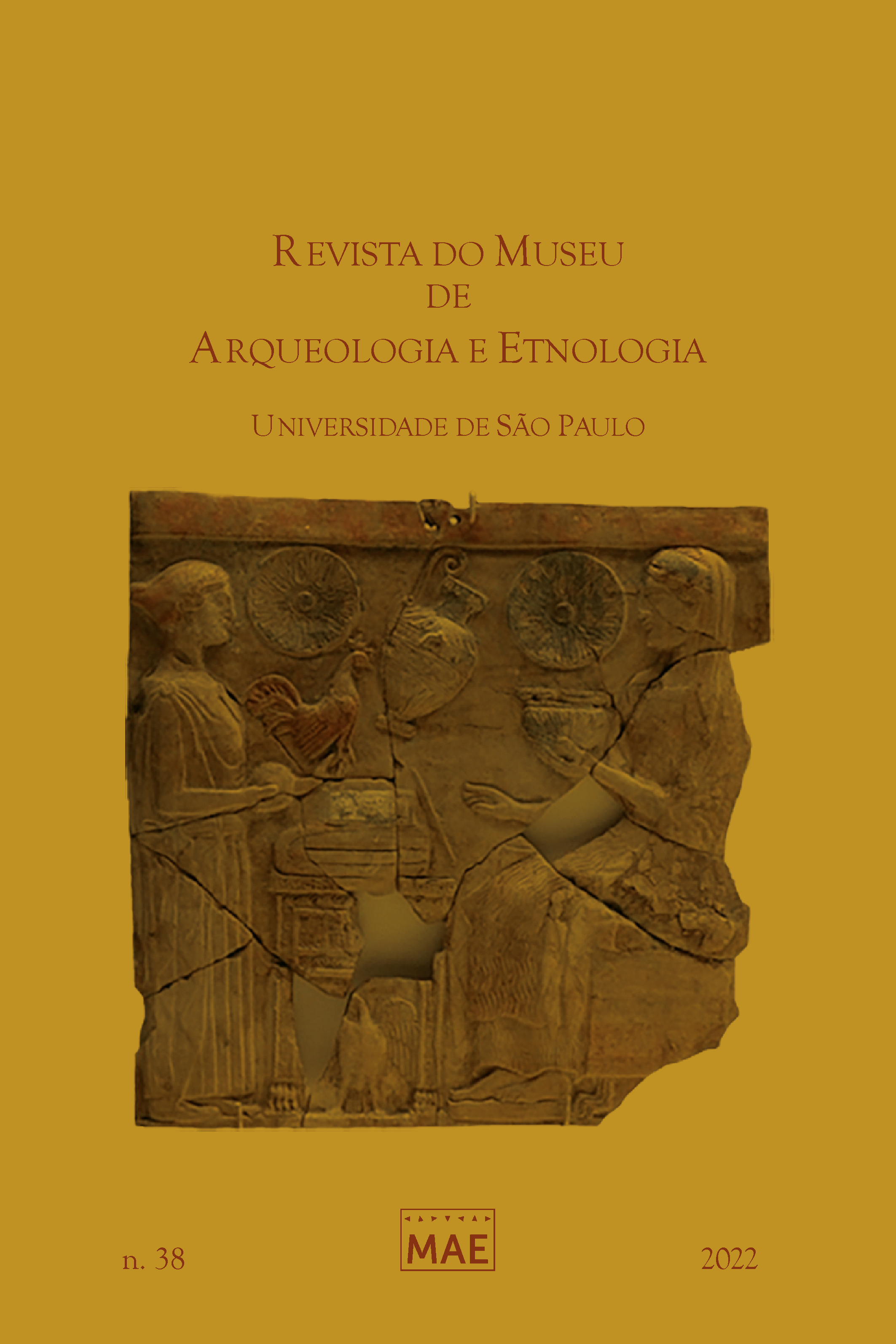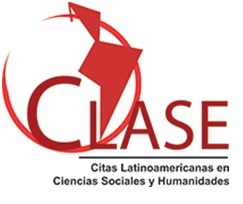A relação de Esparta, Élis e das pólis tessálias com seus periecos e o problema da “pólis Lacedemônia”
DOI:
https://doi.org/10.11606/issn.2448-1750.revmae.2022.186673Palavras-chave:
Esparta, Élis, Tessália, Periecos, PólisResumo
Pode-se dizer que, desde ao menos a segunda metade do século XIX, a pólis foi a unidade básica de análise da história da Grécia antiga. Entretanto, em muitos casos é evidente que a tentativa de adequar as pólis gregas a cidades-Estado prototípicas do Estado moderno produziu ressonâncias longevas, que até hoje condicionam nossa compreensão das relações sociopolíticas entre vários grupos que compunham as pólis. Portanto, o objetivo desse artigo é demonstrar como as raízes dessa historiografia baseada na pólis condicionaram uma compreensão errônea da relação entre Esparta e as comunidades periecas da Lacônia e Messênia durante o Período Clássico. Isso será feito por meio da comparação dessa relação com aquela mantida por outras pólis com seus respectivos periecos – mais especificamente Élis e as pólis tessálias. Veremos que, ao invés de um Estado unificado e com funcionamentos análogos aos de sua versão moderna, a soma de Esparta e seus vizinhos compunha uma comunidade politicamente muito menos hierárquica e rígida do que se tende a pensar. Isso, por sua vez, nos permite aproximar Esparta de fenômenos análogos contemporâneos a ela, os mesmos que, apesar das respectivas especificidades, ainda apontam para a inexistência de uma pólis-Estado que englobasse cidadãos de uma cidade central e seus periecos.
Downloads
Referências
Assumpção, L.F.B. de O. 2014. Discurso e representação sobre as práticas rituais dos esparciatas e dos seus basileus na lacedemônia do século V a.C. Dissertação de mestrado. Universidade do Estado do Rio de Janeiro, Rio de Janeiro.
Assumpção, L.F.B. de O. 2015. A hegemonia política dos espartanos e formas de violência simbólica com os periecos e hilotas na Lacedemônia, do Período Clássico. Revista Digital Simonsen 1: 78-100.
Bourke, G. 2018. Elis: internal politics and externa policy in Ancient Greece. Routledge, London.
Canlas, G. 2017. Negotiating identities: material expressions of cult in Perrhaibia. In: Rupp, D.W.; Tomlinson, J. E. (Eds.). From maple to olive: proceedings of a colloquium to celebrate the 40th anniversary of the Canadian Institute in Greece, Athens, 10-11 June 2016. Canadian Institute in Greece, Atenas, 461-484.
Cartledge, P. 1987. Agesilaus and the crisis of Sparta. Johns Hopkins University Press, Baltimore.
Cartledge, P. 2002. Sparta and Lakonia: a regional history 1300-362 BC. Routledge, London.
Cartledge, P. 2012. Perioikoi. In: Hornblower, S.; Spawforth, A.; Eidinow, E. (Eds.). The Oxford Classical Dictionary. Oxford University Press, Oxford, 1107-1108.
Cavaignac, E. 1948. Sparte. Librarie Arthème Fayard, Paris.
Chrimes, K.M.T. 1949. Ancient Sparta: a re-examination of the evidence. Manchester University Press, Manchester.
Christesen, P. 2018. The typology and topography of Spartan burials from the protogeometric to the Hellenistic Period: rethinking Spartan exceptionalism and the ostensible cessation of adult intramural burials in the Greek World. Annual of the British School at Athens 113: 307-363.
Christesen, P. 2021. Hedorotus 9.85 and Spartiate burial customs. Classica et Mediaevalia 69: 1-72.
Christien, J. 1989. Les liaisons entre Sparte et son Territoire malgre l’encadrement montagneux. In: Bergier, J.-F. (Ed.). Montagnes, fleuves, forets dans l’histoire: barrieres ou lignes de convergence? Scriptae Mercaturae Verlag, St. Katarinen, 17-44.
Christien, J. 2006. The Lacedaemonian State: fortifications, frontiers and historical problems. In: Hodkinson, S.; Powell, A. (Eds.). Sparta & war. Classical Press of Wales, Swansea, 163-183.
Diodorus Siculus. 1954. Library of history. Harvard University Press, Cambridge, (MA) vol. 6.
Ducat, J. 2010. The ghost of the Lacedaemonian State. In: Powell, A.; Hodkinson, S. (Eds.). Sparta: The Body Politic. Classical Press of Wales, Swansea, 183-210.
Ducat, J. 2018. The Perioikoi. In: Powell, A. (Ed.). A companion to Sparta. Wiley Blackwell, Hoboken, 596-614.
Ehrenberg, V. 1924. Spartiaten und Lakedaimonier. Hermes 59: 23-73.
Figueira, T.J. 2018. Helotage and Spartan economy. In: Powell, A. (Ed.). A companion to Sparta. Wiley Blackwell, Hoboken, 565-595.
Forrest, W.G. 1968. A history of Sparta, 950-192 BC. W. W. Norton & Company, London.
Forster, E. 1903-1904. South-Western Laconia: inscriptions. Annual of the British School at Athens 10: 167-189.
Fustel de Coulanges, N.D. 2009. A cidade antiga. Martin Claret, São Paulo.
Gallego, J. 2005. The Lakedaimonian Perioikoi: military subordination and cultural dependence. In: Anastasiadis, V.; Doukellis, P.N. (Eds.). Esclavage antique et discriminations socio-culturelles. Peter Lang, Berna, 33-58.
Giangiulio, M. 2009. The emergence of Pisatis. In: Funke, P.; Luraghi, N. (Eds.). The politics of ethnicity and the crisis of the Peloponnesian League. Harvard University Press, Cambridge (MA), 65-85.
Glotz, G. 1938. Histoire grecque. Presses Universitaires de France, Paris, vol. 1.
Graninger, D. 2011. Cult and koinon in Hellenistic Thessaly. Brill, Leiden.
Gschnitzer, F. 1954. Namen und Wesen der thessalischen Tetraden”. Hermes 82: 451-464.
Gschnitzer, F. 1958. Abhängige Orte im griechischen Altertum. Beck, Munique.
Guintrand, M. 2016. Les fortifications dans le système défensif lacédémonien à l’époque classique. In: Frederiksen, R. et al. (Eds.). Focus on fortifications: new research on fortifications in the ancient Mediterranean and the Near East. Oxbow Books, Oxford, 435-445.
Guintrand, M. 2017. Sparte et la defense du Péloponnèse meridional du milieu du VIe Siècle au milieu du IIe siecle av. J.C. Tese de Doutorado. Université d’Avignon et des Pays de Vaucluse, Avignon, vol. 1.
Haagsma, M.J.; Surtees, L.; Chykerda C.M. 2019. Ethnic constructs from inside and out: external policy and the ethnos of Achaia Phthiotis. In: Beck, H.; Buraselis, K.; McAuley, A. (Eds.). Ethnos and Koinon: studies in Ancient Greek ethnicity and federalism. Franz Steiner Verlag, Stuttgart, 285-319.
Hall, J.M. 2000. Sparta, Lakedaimon and the nature of Perioikic dependency. In: Flensted-Jensen, P. (Ed.). Further studies in the Ancient Greek Poleis. Franz Steiner Verlag, Stuttgart, 73-89.
Hampl, F. 1937. Die lakedämonischen Periöken. Hermes 72: 1-49.
Hansen, M.H. 2006. Polis: an introduction to the Ancient Greek city-state. Oxford University Press, Oxford.
Hatzopoulos, M. 2000. “L’Histoire par les Noms” in Macedonia. In: Hornblower, S.; Matthews, E. (Eds.). Greek personal names: their value as evidence. Oxford University Press, Oxford, 99-117.
Hawkins, C. 2011. Spartans and Perioikoi: the organization and ideology of the Lakedaimonian Army in the fourth century B.C.E. Greek, Roman, and Byzantine Studies 51: 401-434.
Helly, B. 1995. L’État thessalien: Aleuas le Roux, les tetrades et les Tagoi. Maison de l’Orient et de la Méditerranée, Lyon.
Herodotus. 1921. The Persian wars. Harvard University Press, Cambridge (MA), vol. 2.
Herodotus. 1922. The Persian wars. Harvard University Press, Cambridge (MA), vol. 3.
Hodkinson, S. 2009. Was Sparta an exceptional polis? In: Hodkinson, S. (Ed.) Sparta: comparative approaches. Classical Press of Wales, Swansea, 417-472.
Hodkinson, S. 2015. Transforming Sparta: new approaches to the study of Spartan Society. In: Beness, J.L. (Ed.). Ancient history: resources for teachers. Macquarie Ancient History Association, Sydney, 1-45.
Homer. 1919. Odyssey. Harvard University Press, Cambridge (MA), vol. 1-2.
Homer. 1924. Iliad. Harvard University Press, Cambridge (MA), vol. 1.
Huxley, G.L. 1962. Early Sparta. Faber and Faber, London.
Isocrates. 1919. On the Peace. Areopagiticus. Against the Sophists. Antidosis. Panathenaicus. Harvard University Press, Cambridge (MA).
Jacoby, F. 1986. Die Fragmente der griechischen Historiker. Brill, Leiden, vol. 2A.
Jacoby, F. 1993. Die Fragmente der griechischen Historiker. Brill, Leiden, vol. 3B.
Kahrstedt, U. 1922. Griechisches Staatsrecht: Sparta und seine Symmachie. Vandenhoeck and Ruprecht, Göttingen.
Kennell, N.M. 1999. From Perioikoi to Poleis: the Laconian cities in the Late Hellenistic Period. In: Hodkinson, S.; Powell, A. (Eds.). Sparta: new perspectives. Duckworth, London, 189-210.
Kennell, N.M. 2010. Spartans: a new history. Wiley-Blackwell, Malden.
Kiechle, F. 1960. Das Verhältnis von Elis, Triphylien und der Pisatis im Spiegel der Dialecktunterschiede. Rheinisches Museum für Philologie 103: 336-366.
Koiv, M. 2003. Ancient tradition and early Greek history: the origins of states in early-archaic Sparta, Argos and Corinth. Avita, Tallinn.
Koiv, M. 2013. Early history of Elis and Pisa: invented or evolving traditions? Klio 95: 15-68.
Kravaritou, S. 2011. Synoecism and religious interface in Demetrias (Thessaly). Kernos 24: 111-135.
Larsen, J.A.O. 1937. Περίοικοι (Perioiken). In: Wissowa, G.; Kroll, W.; Mittelhaus, K. (Eds.). Paulys Realencyclopädie der classischen Altertumswissenschaft. J. B. Metzlersche Verlagsbuchhandlung, Stuttgart, 816-833.
Larsen, J.A.O. 1970. Perioikoi. In: Hammond, N.G.L.; SCULLARD, H.H. (Eds.). The Oxford Classical Dictionary. Oxford University Press, Oxford, 801.
Lehmann, G.A. 1987. Thessaliens Hegemonie über Mittelgriechenland im 6. Jh. v. Chr. Boreas 6: 35-43.
Lévy, E. 2003. Sparte: histoire politique et sociale jusqu’à la conquête romaine. Seuil, Paris.
Link, S. 1994. Der Kosmos Sparta: Recht und Sitte in klassischer Zeit. Wissenschaftliche Buchgesellschaft, Darmstadt.
Low, P. 2006. Commemorating the Spartan War-Dead. In: Hodkinson, S.; Powell, A. (Eds.). Sparta & war. Classical Press of Wales, Swansea, 85-110.
Luraghi, N. 2003. The imaginary conquest of the Helots. In: Luraghi, N.; Alcock, S.E. (Eds.). Helots and their masters in Laconia and Messenia: histories, ideologies, structures. Harvard University Press, Cambridge (MA), 109-142.
Luraghi, N. 2008. The ancient Messenians: constructions of ethnicity and memory. Cambridge University Press, Cambridge.
Macdowell, D.M. 1986. Spartan law. Scottish Classical Studies, Edinburg.
Merkelbach, R.; West, M.L. 1967. Fragmenta hesiodea. Clarendon Press, Oxford.
Michell, H. 1952. Sparta. Cambridge University Press, Cambridge.
Minon, S. 2007. Les inscriptions éléennes dialectales (VIe-IIe siècle avant J.-C.). Droz, Genebra, vol. I.
Neumann, K.J. 1906. Die Entstehung des spartiatischen Staates in der lykurgischen Verfassung. Historische Zeitschrift 96: 1-80.
Nielsen, T.H. 1995. Was Eutaia a polis? A note on Xenophon’s use of the term polis in the Hellenika. In: Hansen, M.H.; Raaflaub, K. (Eds.). Studies in the Ancient Greek Polis. Franz Steiner Verlag, Stuttgart, 83-102.
Nielsen, T.H. 1996. A Survey of dependent poleis in Arkadia. In: Hansen, M.H.; Raaflaub, K. (Eds.). More studies in the Ancient Greek polis. Franz Steiner Verlag, Stuttgart, 63-105.
Nielsen, T.H. 1997. Triphylia: an experiment in ethnic construction and political organisation. In: Nielsen, T.H. (Ed.). Yet more studies in the Ancient Greek polis. Franz Steiner Verlag, Stuttgart, 128-162.
Niese, B. 1906. Neue Beiträge zur Geschichte und Landeskunde Lakedämons: die lakedämonischen Periöken. Nachrichten von der königlischen Gesellschaft der Wissenschaften zu Göttingen 2: 101-142.
Niese, B. 1910. Drei Kapitel eleischer Geschichte. In: Robert, C. Genethliakon. Weidmannsche Buchhandlung, Berlim, 3-47.
Oliva, P. 1971. Sparta and her social problems. Hakkert, Indianapolis.
Pareti, L. 1920. Storia di Sparta arcaica. Felice le Monnier, Florenza, parte 1.
Parker, R. 1989. Spartan religion. In: Powell, A. (Ed.). Classical Sparta: techniques behind her success. Routledge, London, 142-172.
Parker, R. 2009. Subjection, synoecism and religious life. In: Funke, P.; Luraghi, N. (Eds.). The politics of ethnicity and the crisis of the Peloponnesian League. Harvard University Press, Cambridge (MA), 183-214.
Pausanias. 1926. Description of Greece. Harvard University Press, Cambridge (MA), vol. 2.
Pavlides, N. 2018. The sanctuaries of Apollo Maleatas and Apollo Tyritas in Laconia: religion in Spartan-Perioikic relations. Annual of the British School at Athens 112: 1-27.
Pavlides, N. 2020. Non-Spartans in the Lakedaimonian Army: the evidence from Laconia. Historia 69: 154-184.
Pindar. 1997. Olympian odes. Pythian odes. Harvard University Press, Cambridge (MA).
Ribeiro, M.C.L. 2017. Esparta Katà Kómas: organização espacial do território (VIII-V a.C.). In: Atas Congresso Histórico Internacional “As cidades na história”, 2017, Guimarães.
Ribeiro, M.C.L. 2019. Esparciatas e periecos: identidade comum em torno do culto a Apolo. In: Mota, A.J.; Campos, C.E. da C. (Orgs.). Sistemas de crenças, mitos e rituais na antiguidade. Desalinho, São João de Meriti, 117-144.
Richer, N. 1998. Les Ephores: études sur l’histoire et sur l’image de Sparte (VIIIe-IIIe Siècles avant Jésus-Christ. Publications de la Sorbonne, Paris.
Ridley, R.T. 1974. The economic activities of the Perioikoi. Mnemosyne 27: 283-292.
Ritschelio, F. 1864. Hesychii Alexandrini lexicon. Typis Maukij, Ienae.
Rose, V. 1886. Aristotelis qui ferebantur librorum fragmenta. Teubneri, Lipsiae.
Roy, J. 1997. The Perioikoi of Élis. In: Hansen, M.H. (Ed.). The polis as an urban centre and as a political community. Kongelige Danske Videnskabernes Selskab; Munksgaard, Copenhagen, 282-320.
Roy, J. 2002. The synoikism of Elis. In: Nielsen, T.H. (Ed.). Even more studies in the Ancient Greek polis. Franz Steiner Verlag, Stuttgart, 249-264.
Roy, J. 2009a. Elis. In: Funke, P.; Luraghi, N. (Eds.). The politics of ethnicity and the crisis of the Peloponnesian League. Harvard University Press, Cambridge (MA), 30-48.
Roy, J. 2009b. Hegemonial structures in late archaic and early classical Elis and Sparta. In: Hodkinson, S. (Ed.). Sparta: comparative approaches. Classical Press of Wales, Swansea, 69-88.
Ruggeri, C. 2004. Gli stati intorno a Olimpia: storia e costituzione dell’Elide e degli stati formati dai Perieci Elei (400-362 a.C.). Franz Steiner Verlag, Stuttgart.
Ruggeri, C. 2009. Triphylia from Elis to Arcadia. In: Funke, P.; Luraghi, N. (Eds.). The politics of ethnicity and the crisis of the Peloponnesian League. Harvard University Press, Cambridge (MA), 49-64.
Salapata, G. 2014. Heroic offerings: the terracotta plaques from the Spartan sanctuary of Agamemnon and Kassandra. University of Michigan Press, Ann Arbor.
Sekunda, N. 2009. IG V.1 1124: the dead of Geronthrai fallen at Mantineia. In: Cavanagh, H.; Cavanagh, W.; Roy, J. (Eds.). Honouring the dead in the Peloponnese. Centre for Spartan and Peloponnesian Studies, Nottingham, 719-724.
Shipley, G. 1992. Perioikos: the discovery of classical Lakonia. In: Sanders, J. M. (Ed.). Φιλολάκων: Lakonian studies in honour of Hector Catling. British School at Athens, Oxford, 211-226.
Shipley, G. 1997. “The other Lakedaimonians”: the dependent Perioikic poleis of Laconia and Messenia. In: Hansen, M.H. (Ed.). The polis as an urban centre and as a political community. Kongelige Danske Videnskabernes Selskab; Munksgaard, Copenhagen, 189-281.
Shipley, G. 2004. Lakedaimon. In: Hansen, M.H.; Nielsen, T.H. (Eds.). An inventory of archaic and classical Poleis. Oxford University Press, Oxford, 569-599.
Shipley, G. 2006. Sparta and its Perioikic neighbours: a century of reassessment. Hermathena 181: 51-82.
Siewert, P. 1987-1988. Triphylien und Akroreia. Spartanische „Regionalstaaten” in der westlichen Peloponnes. Πελοποννησιακά 13: 7-12.
Siewert, P. 1994. Symmachien in neuen Inschriften von Olympia: zu den sogenannten Periöken der Eleer. In: Aigner-Foresti, L. et al. (Eds.). Federazioni e federalismo nell’Europa antica I. Vita e Pensiero, Milano, 257-264.
Sprawski, S. 2009. Thessalians and their neighbours in the Classical Period. In: 1º Διεθνές Συνέδριο Ιστορίας & Πολιτισμού της Θεσσαλίας, 2009, Περιφέρεια Θεσσαλίας, Tessalônica, 131-137.
Strabo. 1927. Geography. Harvard University Press, Cambridge (MA), vol. 4.
Thommen, L. 1996. Lakedaimonion Politeia: die Entstehung der spartanischen Verfassung. Franz Steiner Verlag, Stuttgart.
Thommen, L. 2013. Spartas Verhältnis zu Elis und Olympia. In: Birgalias, N. et al. (Eds.). War: peace and panhellenic games. Kardamitsa, Atenas, 329-344.
Thucydides. 1919. History of the Peloponnesian War. Harvard University Press, Cambridge (MA), vol. 1.
Thucydides. 1920. History of the Peloponnesian War. Harvard University Press, Cambridge (MA), vol. 2.
Thucydides. 1921. History of the Peloponnesian War. Harvard University Press, Cambridge (MA), vol. 3.
Thucydides. 1923. History of the Peloponnesian War. Harvard University Press, Cambridge (MA), vol. 4.
Villafane, C. 2018. Go tell the… Lacedaemonians? Sparta’s reliance on the Perioikoi during times of conflict. In: Brouma, V.; Heydon, K. (Eds.). Conflict in the Peloponnese: social, military and intellectual. Centre for Spartan and Peloponnesian Studies, Nottingham, 133-149.
Vlassopoulos, K. 2007. Unthinking the Greek polis: Ancient Greek history beyond eurocentrism. Cambridge University Press, Cambridge.
Wallner, B. 2008. Die Perioiken im Staat Lakedaimon. Verlag Dr. Kovac, Hamburg.
Wilcken, U. 1973. Griechische Geschichte im Rahmen der Altertumsgeschichte. R. Oldenbourg Verlag, München.
Xenophon. 1918. Hellenica. Harvard University Press, Cambridge (MA), vol. 1.
Xenophon. 1921. Hellenica. Harvard University Press, Cambridge (MA), vol. 2.
Xenophon. 1998. Anabasis. Harvard University Press, Cambridge (MA).
Downloads
Publicado
Edição
Seção
Licença
Copyright (c) 2022 Gabriel Cabral Bernardo

Este trabalho está licenciado sob uma licença Creative Commons Attribution-NonCommercial-NoDerivatives 4.0 International License.
Dados de financiamento
-
Fundação de Amparo à Pesquisa do Estado de São Paulo
Números do Financiamento Processo número 2019/00327-6


















